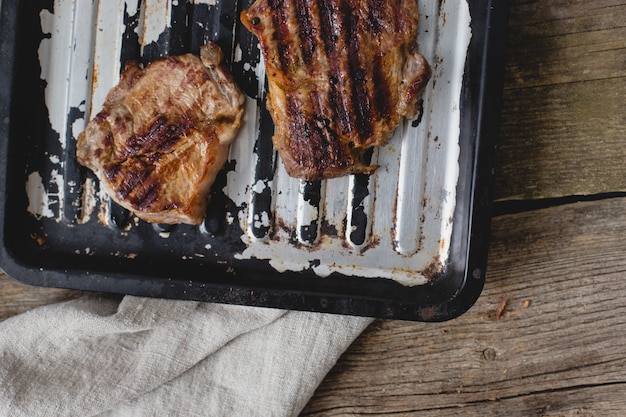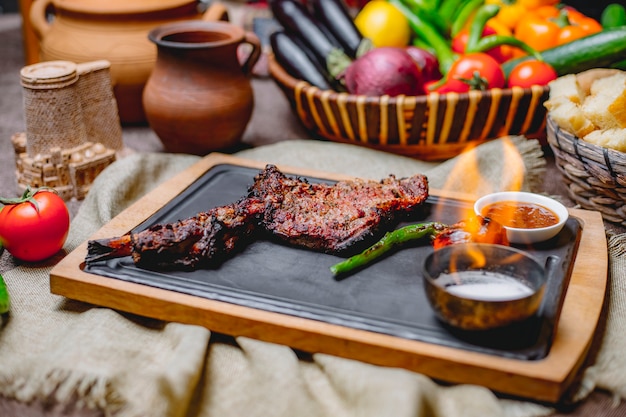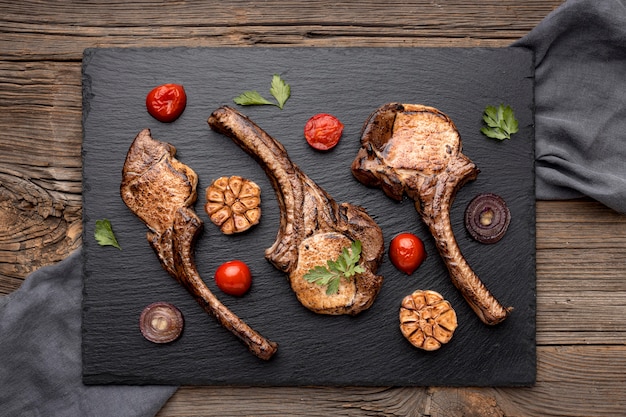Ah, the standing rib roast. A culinary titan, a symbol of Sunday feasts, and the star of countless celebratory meals. But let's be honest, it can also be a bit intimidating. I've been there, staring at the massive hunk of meat wondering how on earth I was going to cook it perfectly without turning it into a dry, disappointing mess. But trust me, it's not as hard as it seems.
This guide is your roadmap to mastering the standing rib roast. We'll cover everything from choosing the right cut to understanding different cooking methods and, most importantly, how to nail that perfect cooking time. We'll even tackle those pesky questions that pop up and leave you scratching your head. So, grab a glass of wine, gather your culinary courage, and let's dive into the delicious world of the bone-in standing rib roast.
Part 1: Understanding the Cut

Before we even think about turning on the oven, let's talk about the star of the show: the standing rib roast. This majestic cut, often called a prime rib roast, is a real showstopper. Think of it as the crown jewel of the beef world, carved from the primal rib, the section between the chuck and the loin. It's usually a hefty piece of meat, with a bone-in section that adds flavour and a distinctive, impressive look to the whole affair.
Types of Standing Rib Roasts
The main contenders in the standing rib roast category are:
english cut: This is the classic, show-stopping cut, featuring 7 ribs and a hefty size that’s perfect for larger gatherings or when you want to make a real statement. It's often the star of formal dinners and family celebrations.
Standing Rib Roast: This is a smaller, more manageable cut, featuring 3 ribs. It's great for smaller groups and weeknight dinners where you don't need to cook a whole herd of beef. It’s also a bit easier to handle, and it’s a great option for a beginner home cook.
Choosing the Right Cut
When selecting your standing rib roast, keep these factors in mind:
Size: The size of the roast should match your needs. You don't want to be stuck with way too much leftover meat (although that's not a terrible problem to have). A general rule of thumb is to allow about 1 pound of meat per person.
Fat Content: Look for a roast with a good amount of marbling and fat. Fat isn't just about taste, it's the secret to keeping the meat juicy during the long cooking process. You'll find that a good layer of fat renders and adds flavour to the meat, creating that delicious, rich gravy you crave.
Quality: For the best results, opt for a high-quality cut of meat, ideally graded as Prime or Choice. You'll be rewarded with a more tender and flavourful roast.
My Personal Preference
Honestly, I’m a big fan of the English cut. There's something so impressive about a 7-rib roast. It's a true centrepiece, a conversation starter, and it just screams "special occasion!" But the smaller standing rib roast is a great option for those who don't want to commit to such a massive hunk of meat. Ultimately, the right choice depends on your needs, your preferences, and the number of people you're serving.
Part 2: Prepping the Roast

Once you've chosen your perfect roast, it's time for the pre-game prep. This is a crucial step. It’s where many home cooks go wrong, resulting in a dry or unevenly cooked roast. But fear not, with a little care, you’ll be on your way to a perfectly cooked masterpiece.
Pat it Dry
First things first, pat the roast dry with paper towels. This will help the meat brown nicely and prevent it from steaming during cooking. We want that beautiful, crispy exterior, not a soggy mess.
Seasoning It Up
Now, the fun part! Seasoning the roast is your opportunity to add your personal touch and let your culinary creativity shine. You can go simple with just salt and pepper, or get adventurous with a blend of herbs and spices. I like to add a little garlic powder, paprika, and maybe a touch of dried thyme. But feel free to experiment and find what you like best. Remember, there are no rules in the kitchen, just guidelines. You could even add a rub, a dry spice mix that coats the meat and provides a burst of flavour.
Let It Rest
Here's a crucial tip that many cooks miss: let the roast come to room temperature before cooking. I know it sounds counterintuitive, but it’s vital. It helps the meat cook more evenly, preventing the outside from getting overcooked while the center is still raw. Give it at least 30 minutes to rest before throwing it in the oven.
Part 3: Cooking Methods

Now that your roast is prepped and ready to go, let's discuss the cooking methods. The good news is, you've got options. Each method brings its own unique benefits and flavour profile to the table, so it's all about choosing the right one for you and your preferences.
Roasting in the Oven
The classic method, oven roasting is a tried-and-true way to cook a standing rib roast. It's simple, consistent, and delivers a delicious result.
Preheating the Oven
Start by preheating your oven to 450°F (232°C). This high temperature helps sear the roast and creates a beautiful crust. It also locks in moisture, so you're not losing those precious juices.
Searing the Roast
Place the roast in a roasting pan, and get ready to sear. This step is important for achieving a nice crust and adding flavour to the meat. Sear the roast for 15 minutes on each side, making sure to get a good, even brown.
Lowering the Temperature
After the searing, reduce the oven temperature to 325°F (163°C). This lower temperature allows the meat to cook slowly and evenly, ensuring that it reaches a safe internal temperature without overcooking the outside.
Adding Moisture
For extra moisture and to prevent the roast from drying out, add a cup of water or beef broth to the bottom of the roasting pan. The steam it creates helps keep the meat juicy and tender.
Using a slow cooker
For a hands-off approach, the slow cooker is a great option. It's perfect for those busy days when you don't want to fuss around in the kitchen.
Searing Before slow cooking
I highly recommend searing the roast before adding it to the slow cooker. This step adds that beautiful crust and a depth of flavour that you won't get by simply plopping the roast in the slow cooker.
Cooking Time
For a 5-rib standing rib roast, cook on low for 6-8 hours. For a 7-rib roast, cook for 8-10 hours. The slow cooker does all the work, allowing you to focus on other things while the roast cooks to perfection.
Adding Moisture
Add a cup of beef broth or water to the slow cooker. This helps keep the meat moist and creates a delicious sauce that you can use to baste the roast or serve on the side.
Grilling the Roast
Grilling brings a whole new dimension of flavour to the table. That smoky, charcoal flavour is simply irresistible.
Choosing the Right Grill
For a standing rib roast, you'll need a large gas or charcoal grill with a lid. You need the space to accommodate the roast and the ability to control the temperature.
Grilling Time
Cook over indirect medium heat (300°F) for about 2-3 hours, or until the internal temperature reaches 135°F for medium-rare. Use a meat thermometer to ensure the roast reaches the desired internal temperature.
Adding Moisture
To keep the roast moist and prevent it from drying out, add a drip pan to the bottom of the grill and fill it with water. This helps create steam and keeps the meat juicy and tender.
Part 4: Determining Cooking Time
Now, let's talk about the big question: how long do you cook a standing rib roast? This is where it can get tricky, as you're aiming for a happy medium between fully cooked and still juicy.
Factors Affecting Cooking Time
The following factors influence how long your roast needs to cook:
Size of the Roast: Larger roasts require more time to cook through. Think of it as a bigger roast taking longer to warm up.
Oven Temperature: Lower temperatures generally require longer cooking times. A slower cook allows the heat to penetrate more evenly.
Desired Doneness: The level of doneness you prefer will affect the cooking time. A rare roast will take less time than a well-done roast.
Cooking Time Chart
Here's a general guide for cooking times based on size and desired doneness. Remember, these are just estimates, and it's always best to use a meat thermometer to ensure the roast reaches the desired internal temperature:
| Size of Roast (Ribs) | Rare (125°F) | Medium-Rare (135°F) | Medium (145°F) | Well-Done (160°F) |
|---|---|---|---|---|
| 3 Rib Roast | 1.5-2 Hours | 2-2.5 Hours | 2.5-3 Hours | 3-3.5 Hours |
| 5 Rib Roast | 2-2.5 Hours | 2.5-3 Hours | 3-3.5 Hours | 3.5-4 Hours |
| 7 Rib Roast | 2.5-3 Hours | 3-3.5 Hours | 3.5-4 Hours | 4-4.5 Hours |
Using a Meat Thermometer
Always, always, always use a meat thermometer! This is your secret weapon. It's the only way to know for sure if your roast has reached the desired internal temperature. Insert the thermometer into the thickest part of the roast, avoiding the bone. The internal temperature should reach:
125°F for rare
135°F for medium-rare
145°F for medium
160°F for well-done
Resting the Roast
Once your roast reaches the desired internal temperature, take it out of the oven (or off the grill) and let it rest for at least 15 minutes before carving. This allows the juices to redistribute, resulting in a more tender and juicy roast. It's a crucial step that's often overlooked, but it makes a world of difference.
Part 5: Making the Most of the Roast
Your standing rib roast is already a star, but we can elevate it to new heights of deliciousness. It's time to explore those flavour-boosting techniques that make this dish truly memorable.
Creating a Delicious Sauce
Let's talk about the pan drippings – pure liquid gold. Don't even think about throwing those away!
Deglazing the Pan
After the roast has rested, pour the pan drippings into a saucepan. Add a splash of red wine or beef broth and scrape up any browned bits from the bottom of the pan. Those crispy, caramelized bits are flavour bombs waiting to be released.
Simmering the Sauce
Bring the sauce to a simmer and cook until it thickens slightly. The simmering process intensifies the flavour and creates a rich, delicious sauce. You can even add a tablespoon of butter for extra richness.
Strain the Sauce
Strain the sauce through a fine-mesh sieve to remove any impurities. You can serve the sauce separately or spoon it over the roast. A generous drizzle of this delicious gravy adds another layer of flavour and moisture.
Sides that Compliment
A standing rib roast deserves equally impressive sides. Here are some classic pairings:
Roasted Vegetables: roasted asparagus, Brussels sprouts, or carrots are a perfect complement to the roast. They add colour, texture, and a burst of freshness.
mashed potatoes: creamy mashed potatoes are a classic pairing, offering a comforting and comforting contrast to the rich flavour of the roast.
Yorkshire Pudding: This traditional British side is a must-have with a standing rib roast. It’s a crispy, fluffy, and savoury side dish that adds a delightful textural contrast to the tender roast.
Part 6: Serving the Roast
Finally, it's time to carve the roast and serve up a feast. Get ready for rave reviews.
Carving the Roast
Use a sharp carving knife and fork to carve the roast. It's a little bit of a show, so don't be afraid to show off your skills.
Slicing Against the Grain
Slice the roast against the grain. This cuts through the muscle fibers, resulting in more tender meat.
Serving the Roast
Arrange the slices on a platter and serve with your chosen sides and gravy. A beautifully carved roast is a sight to behold and adds to the overall appeal of the meal.
Part 7: Leftovers
Let's face it, you're likely going to have some delicious leftovers. But don't worry, there's no need to feel bad about them!
Storing the Roast
Refrigerate the leftovers in an airtight container for up to 3 days. Store them properly, and you'll be able to enjoy them for days to come.
Repurposing Leftovers
There are endless ways to transform those leftover ribs into delicious new meals.
Sandwiches: Slice the leftover roast and use it to make hearty sandwiches. Add some cheese, pickles, and a bit of mustard for a satisfying lunch or dinner.
Soup: Chop up the leftover roast and add it to a hearty soup. It adds a rich and satisfying flavour to any soup.
Pasta: Slice the leftover roast and add it to a pasta dish. It adds a protein boost and a delicious flavour to your favourite pasta recipes.
Part 8: FAQs
You've got questions, I've got answers. Here are some of the most common questions about cooking a standing rib roast:
1. How do I make sure the roast is cooked evenly?
To ensure even cooking, use a meat thermometer to check the internal temperature in multiple spots. Also, rotate the roast halfway through cooking to ensure all sides cook evenly. It’s a little extra effort, but it’s worth it for a perfectly cooked roast.
2. What if the roast is too salty?
Adding a splash of water or broth to the roasting pan can help dilute the saltiness. You can also serve the roast with a side dish that doesn't have much salt, like mashed potatoes or roasted vegetables.
3. Can I cook a standing rib roast in a slow cooker?
Yes, you can! Just sear the roast first for a crispy exterior and then cook it on low for 6-8 hours. It's a great option for a hands-off, slow-cooked roast.
4. Can I freeze a standing rib roast?
Yes, you can freeze a standing rib roast for up to 3 months. Wrap it tightly in plastic wrap and then place it in a freezer bag. This is a great way to stock up on deliciousness.
5. What if the roast is overcooked?
Unfortunately, you can't really "uncook" a roast. But you can try to salvage it by slicing it thinly and serving it with a sauce that will add moisture. You could also use the overcooked meat in a soup or stew.
Final Thoughts
Cooking a standing rib roast can feel like a culinary adventure, but with a bit of knowledge and some practice, you'll be a master in no time. Remember, patience and a good meat thermometer are your best friends. So, get those ingredients ready, fire up the oven, and get ready to impress your guests with a show-stopping standing rib roast. Happy cooking!
Everyone is watching

How to Cook Frozen Lobster Tails Perfectly: A Step-by-Step Guide
RecipesLobster. Just the word conjures up images of lavish meals, special occasions, and a taste of luxury. But let's...

Pigs in a Blanket Cooking Time: How Long to Bake for Perfect Results
RecipesAh, pigs in a blanket. Just the name conjures up images of those delightful little parcels of crispy pastry en...

Pork Fillet Cooking Time: How Long to Cook It Perfectly
RecipesPork fillet, or tenderloin as it's sometimes called, is a real favourite in our house. It's so versatile, and...

The Ultimate Guide to Tender, Juicy Pulled Pork
RecipesRight, let's talk pulled pork. It's one of those dishes that just screams "comfort food," doesn't it? I mean...

The Ultimate Guide to Cooking Sweet Potatoes: From Roasting to Mashing
RecipesSweet potatoes. Just the name conjures up images of warm, comforting dishes, bursts of vibrant color, and a to...
